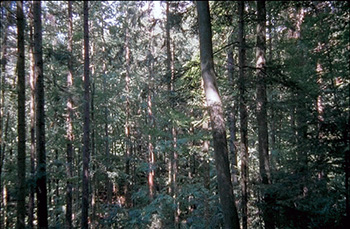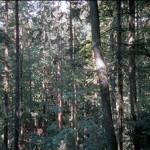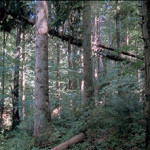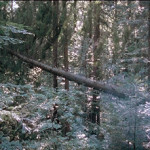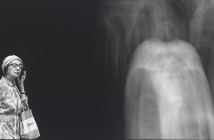By STEPHEN V. KOBASA
These woods are dark and deep; but they are not lovely. This is Ori Gersht's video panorama, The Forest, made in 2005. A stand of trees, indistinct voices, one crack of sound. A hunter, or an execution?
How much of the history of its inspiration do we require to make sense of this piece? Over sixty years ago, Gersht's father-in -law hid, desperate, in these Ukrainian woods. For many other Jews, they were a killing ground. The specifics of those horrors are nowhere noted in the work itself. But the terror is still palpable.
The threat of this place is not simply in its past, and the darkness it contains can be found in other unexpected places - Kitty Genovese dying on a street in Queens while the neighbors wait. But Gersht's revised pastoral relies on those murderous fairy tales of children wandering towards their doom in an indifferent nature.
And there was a child in the auditorium for the showing of the video at the same time as I was, watching. He had questions for his father that he spoke aloud. What he was seeing made him uncertain, but fascinated. All that he did not know protected him, while my memory of what the world has done filled the screen with imminent violence.
That cliché of perception about the sound of a tree falling in the forest without a witness is here transformed into a moral question: what is to be made of those who hear something terrible happening, and do not say anything?
The slow deliberate survey by the lens makes it seem as if a surveillance camera has been mounted in the wilderness. It sees everything, but does nothing. After the first tree sweeps across the frame in its surprise of motion, we are stunned into waiting for what we know must be the next. We never learn why they topple; there is no recording of an ax or a saw.
And once or twice we are tricked as, waiting for crash, a tree comes down without a sound, leaving what looks like a star fall of leaves bright in the sun, and dust making smoke of shafts of light.
In between, these woods are full of noises, like Prospero's island in The Tempest. What we hear is wind or water or breathing. The subject is our own silence.
The paradox of isolating frames from what is meant as a moving picture can have no better example. To use stills from this piece to illustrate it as is being done here is a special kind of misrepresentation. There are few films of my experience in which motion is so central simply because there is so little of it. The before and after of the collapse are absolutely continuous. There can be no preview clips here. We must have all or nothing.
In another part of the museum, several other works by Gersht are on exhibit, one a short film and the others individual photographs. One of those - a floral still life that is literally exploded - erases our fear of what is about to happen, leaving a climax of extinction, with no more to follow.
To come to the end of The Forest, we have to stop looking. A single flicker of vertical line marks the close of the quarter hour video loop. But it means nothing. There is no end to these woods. And no way out of them.
- Ori Gersht, film stills from The Forest, 16 mm film transferred to video in a 13-minute loop, 2005*
"The Forest" is on view until December 30th at the Yale Center for British Art, located at 1080 Chapel St, New Haven, CT.
*Yale Center for British Art. Gift of Alexander F. Cohen, BA '82, MA '85, JD '88, on the occasion of his Yale College 25th Reunion, © courtesy the artist. Images courtesy of Yale Center for British Art

